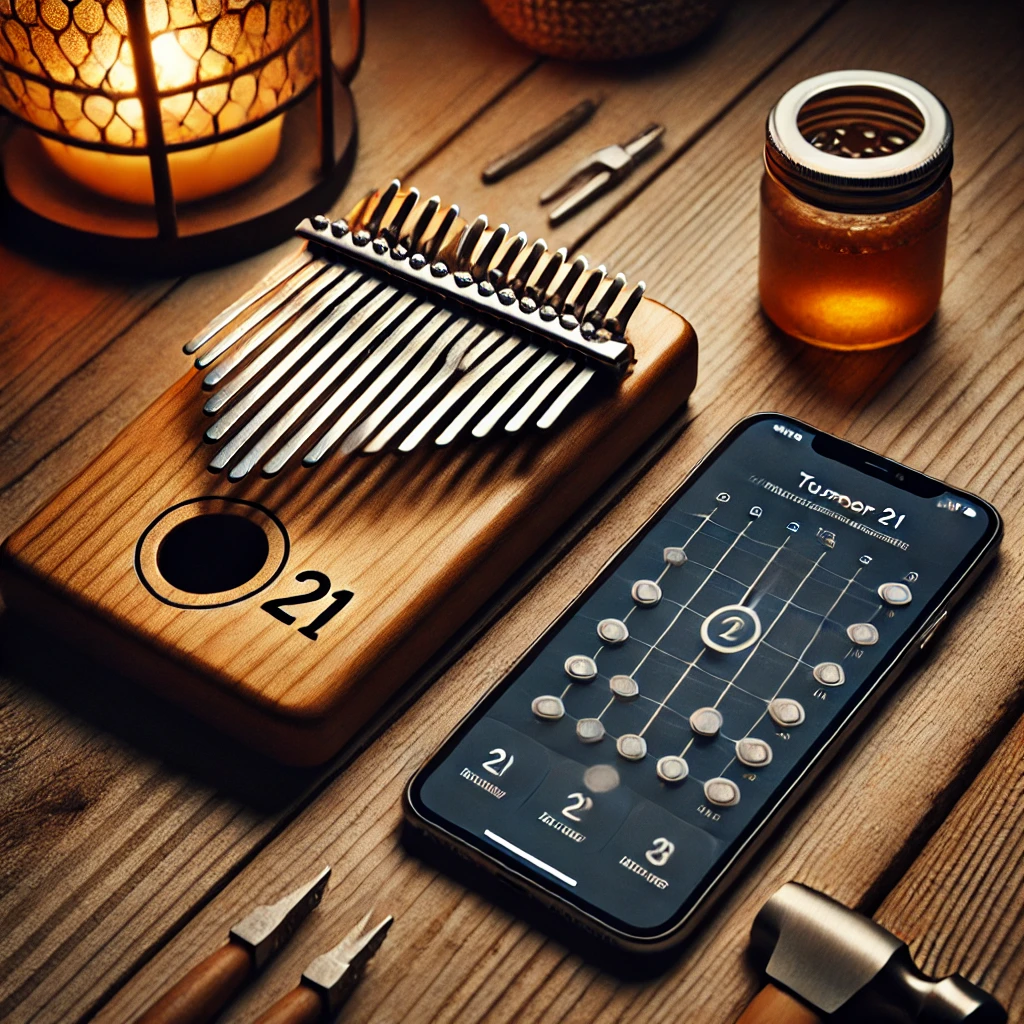Introduction to Kalimba Tuning
Tuning is the key to bringing out the full, harmonious sound of any kalimba, especially with models like the Stagg 21. If you’re new to the instrument, you may not realize how much of an impact proper tuning has on sound quality and playability. A well-tuned kalimba ensures that each note resonates with clarity and harmony, making your playing more enjoyable and professional. Tuning can be tricky, especially for beginners, but thankfully, various tuning software tools can simplify the process, making it easier to achieve perfect notes with every session.
Overview of the Stagg 21 Kalimba
The Stagg 21 kalimba is a popular instrument known for its balanced sound and ease of play. With 21 tines, it offers a broader range than standard 17-key kalimbas, allowing for more complex melodies and harmonies. However, this extended range also makes tuning more intricate, as each time must be precisely adjusted to maintain the kalimba’s characteristic resonance. The Stagg 21’s unique build and tine arrangement makes it an ideal candidate for tuning software, which can provide the necessary precision in aligning each time to its optimal pitch.
Why Proper Tuning is Essential for Stagg 21 Kalimba
An untuned kalimba can make even the simplest melody sound off-key and out of harmony. When each tine of the Stagg 21 is tuned accurately, the result is a rich, full-bodied sound that enhances both playability and listening experience. For musicians, especially beginners, an in-tune kalimba ensures that each note sounds as intended, providing a foundation for learning and practicing with confidence. Proper tuning also extends the life of the kalimba by preventing unnecessary strain on the tines.
Challenges of Tuning a Stagg 21 Kalimba
Tuning a 21-tine kalimba like the Stagg model comes with its own set of challenges. The tines’ metal material, length, and placement can make fine-tuning tricky. For beginners, aligning each tine to the correct pitch can feel daunting, especially since the Stagg 21 has additional notes compared to simpler kalimbas. Manual tuning requires good ear training and a reference pitch, which can be difficult without the right tools. This is why many musicians turn to tuning software to streamline the process.
What is Kalimba Tuning Software?
Kalimba tuning software is a digital tool designed to help players accurately tune their instrument by measuring and displaying each tine’s frequency. The software “hears” the note produced by time and provides real-time feedback on whether the pitch is too high or too low. Many tuning apps are highly sensitive and designed to work with various instruments, including kalimbas. By offering a visual guide, they make tuning more accessible for beginners and experienced players alike, reducing the time and effort required to achieve perfect notes.
Top Recommended Kalimba Tuning Software for Stagg 21
Choosing the right tuning software for your Stagg 21 Kalimba is essential for a smooth tuning experience. Several tuning apps and software options are available, with varying degrees of precision and ease of use. Here are a few popular ones:
- Cleartune: Known for its high sensitivity and accuracy, Cleartune is a widely recommended app for kalimba tuning. It features a chromatic tuner that easily detects the notes from the Stagg 21.
- gStrings Tuner: An Android-compatible option, gStrings provides accurate pitch detection and is ideal for tuning kalimbas. It is customizable, so you can adjust sensitivity and pitch, making it flexible for different tuning needs.
- DaTuner: Another excellent Android app, DaTuner offers a simple interface and high accuracy. Its fast response time allows you to quickly tune each time and move on, making it a favorite among kalimba players.
When choosing a tuning app, look for features like chromatic tuning, pitch sensitivity adjustment, and accuracy. Compatibility with your device is also important, as some apps may not be available on all platforms.
How to Use Tuning Software with Stagg 21 Kalimba
Tuning your Stagg 21 kalimba with software is straightforward, but there are some tips to ensure accurate results. Here’s a step-by-step guide to get started:
- Download and Install: Choose a reliable tuning app, download it, and open the app on your device.
- Place Your Device Close: Position your smartphone or tablet close to the kalimba for the best sound pickup. Most apps use your device’s microphone, so proximity helps.
- Strike Each Tine: Start from the lowest note and gently strike each tine, one at a time. The app will detect the pitch and indicate if the tine is flat (too low) or sharp (too high).
- Adjust as Needed: Use a tuning hammer to adjust the tine’s position based on the app’s feedback. Move the tine up for a higher pitch or down for a lower pitch.
- Verify and Fine-tune: After tuning each tine, play through them once more to ensure accuracy. Fine-tuning might be necessary, as small adjustments can impact neighboring tines.
Tuning software can make this process much faster and more reliable, especially when you are just learning how each time should sound.
Setting the Standard Tuning on Stagg 21 Kalimba
The Stagg 21 Kalimba typically comes in a standard tuning, which is usually set to the key of C major. This tuning aligns well with many popular songs and provides a balanced sound across the tines. Here’s how to tune to C major using software:
- Open Your Tuning App: Most tuning apps automatically detect the key, so start by opening the app and setting it to chromatic mode.
- Tune to C Major: Begin with the central line, which should be tuned to C4. Use the app’s guidance to set the pitch for each time.
- Follow the Tuning Pattern: Move outward from the center, tuning each note according to the C major scale. Common notes for this tuning pattern include C, D, E, F, G, A, and B, following the scale as you move across the tines.
- Check Consistency: Once all tines are tuned, play a few simple melodies to confirm the tuning is correct.
Following these steps with your tuning app will help ensure that your Stagg 21 Kalimba stays in a perfect C major tuning.
Alternative Tunings for Stagg 21 Kalimba
One of the advantages of using a tuning app is the ability to explore alternative tunings, which can open up different musical possibilities. Some popular tunings for the Stagg 21 kalimba include:
- Pentatonic Scale: This tuning uses only five notes per octave, which can give your kalimba a unique, meditative sound. It’s often used in traditional music from various cultures and can be achieved by following a pentatonic scale pattern with your tuning app.
- G Major: Tuning the kalimba to G major allows for a slightly deeper, more resonant sound. It’s ideal for certain genres, such as folk music.
- Minor Tunings: For a melancholic tone, try tuning your Stagg 21 kalimba to a minor scale, like A minor. Many tuning apps allow you to switch between major and minor tunings easily.
Experimenting with different tunings can be fun, and with software, it’s easy to try something new without much effort.
Popular Kalimba Tuning Apps for Mobile Devices
Mobile tuning apps are highly convenient, especially when you need a quick adjustment on the go. Here are some of the top tuning apps you might consider:
- Pano Tuner: Available for both iOS and Android, Pano Tuner offers high sensitivity and a simple interface. It provides visual feedback in real time, making it ideal for quick adjustments.
- Soundcorset Tuner and Metronome: This app not only offers a tuner but also includes a metronome for rhythm practice. It’s precise, easy to use, and works well for Kalimba tuning.
- Tuner Lite: A free app for iOS, Tuner Lite is a good choice if you’re looking for a straightforward, no-frills tuning app that does the job.
Most mobile tuning apps are affordable or free, making them accessible to anyone looking to enhance their kalimba experience.
Detailed Review of ClearTune Tuner
ClearTune is one of the most popular tuning apps for kalimbas due to its high level of accuracy and responsiveness. Here’s a deeper look into what ClearTune offers for Stagg 21 users:
- Chromatic Tuning Mode: ClearTune’s chromatic mode allows it to pick up on a wide range of notes, making it highly suitable for the Stagg 21.
- Display and Feedback: The app provides clear visual feedback, so you can see immediately whether a tine is flat or sharp, and adjust accordingly.
- Fine-tuning Capabilities: ClearTune is known for its precision, allowing users to make micro-adjustments that might be hard to catch with other apps.
Overall, ClearTune is ideal for Stagg 21 Kalimba users looking for an app with sensitivity and professional-level accuracy.
How to Troubleshoot Common Tuning Issues
Occasionally, tuning apps may have trouble picking up on a note or give inconsistent readings. Here’s how to troubleshoot some common issues:
- Poor Sound Pickup: Ensure that your device’s microphone is clean and close to the Kalimba. Ambient noise can interfere with the app’s ability to detect the tone.
- Inconsistent Readings: If the app shows fluctuating results, try adjusting the sensitivity settings. Some apps have a “fine-tune” mode that increases accuracy.
- Wrong Pitch Detection: Sometimes, the app might detect the wrong note if the kalimba is too far out of tune. In this case, make rough adjustments manually before refining with the app.
Troubleshooting is often a matter of adjusting your setup or trying different sensitivity settings within the app.
Tuning the Stagg 21 Kalimba Without Software
If you prefer a more traditional approach, it’s also possible to tune the Stagg 21 Kalimba without software. Here are a few methods:
- Use a Reference Pitch: You can use another tuned instrument, like a piano or digital keyboard, to match each kalimba time to a specific note.
- Use a Tuning Fork: Tuning forks provide a consistent pitch reference, though they are less versatile than digital tuners.
- Ear Training: For those with a good ear, tuning each line by ear is possible. This method takes practice but can be rewarding.
Manual tuning might take longer, but it helps build an ear for pitch and can be a helpful skill for any musician.
Maintaining Tuning Consistency on Stagg 21 Kalimba
After achieving the perfect tuning, keeping your Stagg 21 Kalimba in tune is key to consistent sound quality. Here’s how to ensure your kalimba stays well-tuned:
- Tune Regularly: Daily tuning helps maintain pitch, especially if you play often or in different environments.
- Store Properly: Temperature and humidity can affect kalimba tines. Store your instrument in a stable environment to avoid tuning drift.
- Handle with Care: Rough handling can knock tines out of place, so always handle your kalimba gently.
With regular care, you’ll be able to enjoy a perfectly tuned kalimba for each practice or performance session.
Conclusion and Final Tips for Tuning the Stagg 21 Kalimba
Tuning the Stagg 21 kalimba doesn’t have to be daunting, especially with the help of tuning software. Apps like ClearTune and gStrings offer the precision and convenience needed to keep your kalimba sounding its best. By following the tuning steps and maintaining a regular tuning routine, you’ll enjoy a rich, harmonious sound from your Stagg 21. Whether you stick to the standard tuning or experiment with new scales, tuning software can be an invaluable tool for getting the most out of your kalimba.
FAQs
- Can I use a guitar tuner for my Stagg 21 kalimba?
- Yes, many guitar tuners are chromatic and can detect a range of pitches, but a dedicated tuning app may offer better accuracy for kalimbas.
- How often should I tune my kalimba?
- It’s a good idea to check the tuning before each session, as regular tuning helps maintain sound quality.
- What is the best tuning for beginners on the Stagg 21 kalimba?
- C major tuning is ideal for beginners as it provides a balanced, harmonic sound that’s versatile for many songs.
- Can I change the tuning on my Stagg 21 kalimba?
- Yes, you can explore alternative tunings like pentatonic or G major. Tuning apps make switching between scales easy.
- Why does my Kalimba go out of tune so quickly?
- Environmental factors, frequent play, or tine adjustments can cause the kalimba to go out of tune. Regular tuning and proper storage can help.











Leave a Reply